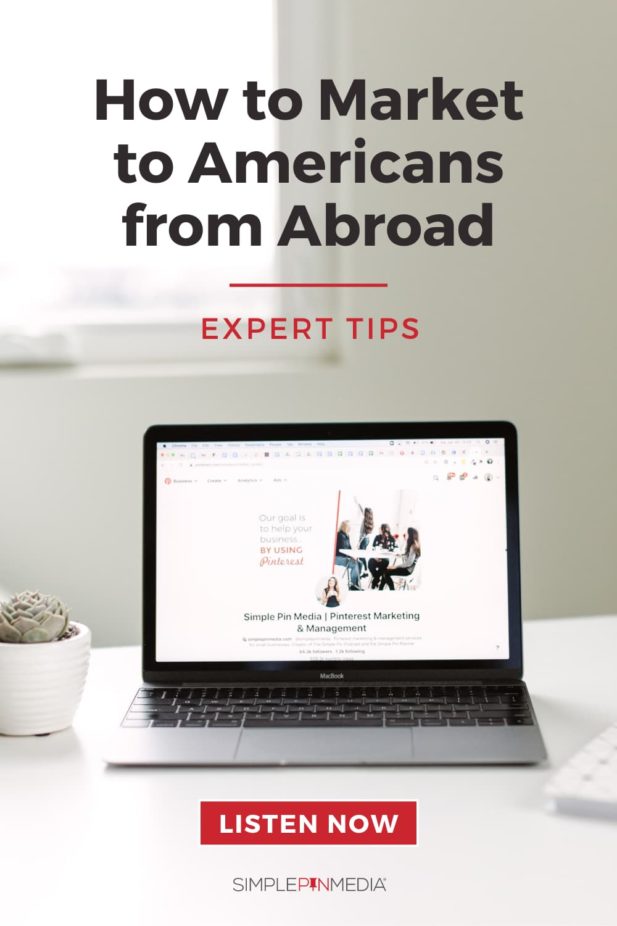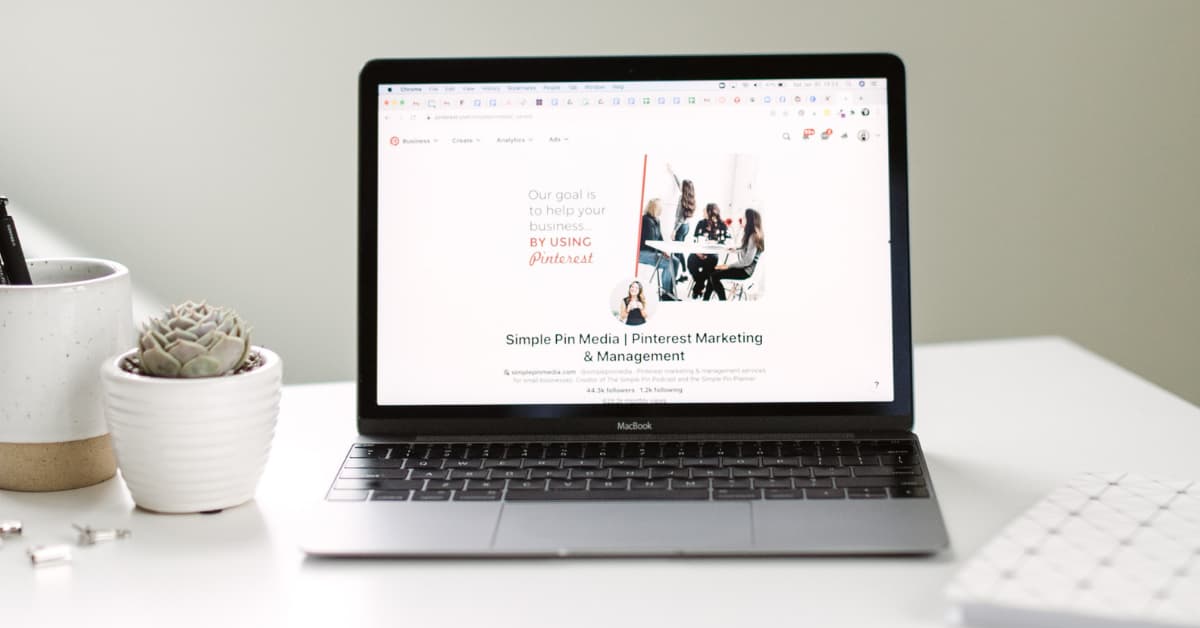All this month we are talking about Pinterest beyond the U.S. borders and the ways to market as an international business or to an international market. Marketing on Pinterest is global, but before you start targeting EVERYONE, you need to know who your audience is and focus on how to reach them specifically. Don’t get caught in the weeds doing all the things.
This week, we are talking specifically about what it’s like to market to an audience that is not in your home country. I’m chatting with Angela Tempest, of Skylark Virtual Services, to hear about her experience living in the UK and what it has been like marketing to both a Canadian audience and a U.S. audience. Angela shared some tips and strategies that will help you think about how you market to a specific country.

Angela is a UK-based Pinterest marketer who manages her own food blog, Pesto & Margaritas. She started her own online business, Skylark Virtual Services, in 2018. Angela serves clients in Canada, the U.S., and the UK.
Angela’s clients come from different niches but she tends to attract clients in the niches she knows well — digital marketing and food. She does have a client who teaches watercolor art to kids and another client who is a photographer and coaches people in photography. She says she’s always up for trying something a little different.
I guess I sort of have a little bit of a mixed bag. It’s always interesting because I get to see Pinterest from different avenues and different perspectives, which can be fun! ~ Angela
Angela hasn’t experienced a need to use any special technology to access different platforms in the UK. (this WAS a challenge a few years back).
She remembers once or twice being locked out of a client’s account. The typical Is this really you? alert was issued and she just asked the client to respond yes. She’s been able to access clients’ accounts without any problems.
Although the tech difficulties are not a challenge working with clients from other countries, Angela acknowledged many other types of challenges that she’s faced.
Challenges Inherent in Marketing to a U.S. Audience from Another Country
Different Holiday Calendars and Seasons
Understanding the little differences between countries is important, especially in the food market. Seasonal differences are not as critical because the Canadian, U.S. and UK markets are all in the northern hemisphere. Differences in holidays, however, are important to understand.
For example, Thanksgiving in Canada comes before Thanksgiving in the U.S. While in the UK, they do not celebrate Thanksgiving at all.
Language Differences (Spelling and Phrases)
Variations in how words are spelled is another important thing to consider in your Pinterest marketing. You need to figure out what terms and keywords work for everyone and which ones need to be specific for different countries and/or different events.
In the UK, words are often spelled with the use of “-our” when “-or” would be used in the U.S. (e.g. favour, colour vs. favor, color) and “s” is often used in the UK where “z” is used in the U.S. (e.g., organisation vs. organization).
Food bloggers likely have up to 75% of their audience coming from the U.S., no matter what their home country. You have to develop a full understanding regarding what spellings and terms you need to use so your blog can be universal. You don’t want a U.S.-based reader to arrive on your site and not understand what you are talking about.
One great example of how language disparities can play out is a Pinterest board on Angela’s food blog account.
She initially named the board Spirits & Cocktails (in the UK, alcohol is referred to as spirits). She discovered that Pinterest was confused by this board title and was misclassifying it. Simplifying the board name to “Cocktail Recipes” enabled the Pinterest AI to understand the content correctly (leading it to come up higher in searches completed by U.S. readers).
Pinterest didn’t understand “Spirits and Cocktails.” It assumed the board was about ghosts. Pinterest was a bit baffled by that. ~Angela
You need to figure out the different terms and how you can work with all of them so that it your content makes sense for everybody. This applies to holidays, food, and seasonal content.
When you are looking to market to a U.S. audience, you have to think about what something is called in the UK and know what they call it in the U.S. Another example can be found in the food niche. In the UK they have chips but they are called french fries in the U.S. Likewise, crisps in the UK are called chips in the U.S.
Pinterest Audience Insights is a somewhat helpful tool for learning differences in terms. Angela finds the Pinterest Trends Tool is the most useful tool for her at the moment.
The Trends Tool allows you to see terms for things that are going to be more popular and if they are different between the U.S. vs. other countries. Trends can also give you foresight as to what terms or products you need to focus on and when to focus on them.
Challenges Specific to Selling Physical Products from Abroad
One of the biggest problems you can run into when selling between countries is the cost of shipping.
You have to be aware of customs fees, shipping fees, and other related international fees. It can be a little more complicated when you are sending parcels abroad.
In the UK they see a lot of U.S. products in their home feed on Pinterest. Users scroll through and find something they like. When they click on it and see it’s a U.S. product, they have to consider the shipping costs involved with the purchase.
When you are marketing on Pinterest, you have to know if you will actually be able to send the product to your customer. You need to think about whether you will be able to send your product for a reasonable shipping price. You have to be able to keep it at a cost that your buyer will be willing to pay.
Related: Using Pinterest to Sell Physical Products
Delay in Getting Access to New Pinterest Features Outside of the U.S.
Another potential marketing hurdle to consider when marketing globally is the delay in receiving the roll-out of new features on Pinterest. We have seen that new features sometimes just aren’t equally available in the global markets. We’ve seen this most recently with story pins.
Story pins have been a nightmare for Angela in the UK. She says they still really don’t have this feature consistently accounts. Most features take two to three months at most to arrive in the UK. Some things even filter through in two weeks. This has not been the case with story pins.
Story pins have been really strange because they are still not universal for the UK accounts. For this reason, right now it can be a bit frustrating to businesses trying to market through Pinterest in the UK.
For Pinterest marketers abroad, one way to handle this delay in the roll-out of new features is to look at any client accounts you have that are U.S.-based. Looking at those accounts, you can become familiar with Pinterest’s new features. You can get an idea of what it’s going to look like when it does arrive and how it will impact what you are doing.
Finding out about the new features and then working at tracking them down for the potential of bringing them to your country will be of benefit to your clients. The more Pinterest marketers in a country that request these new features, the better chance they have of gaining access more quickly.
Lack of an Organized Community for International Pinterest Marketers
We are fortunate to have Pinterest headquarters here in the U.S.. But is there an office in the UK or people running Pinterest for the UK marketers?
There really isn’t much in the UK according to Angela. But she believes that there are more Pinterest marketers now than when she started about two years ago. Angela believes that there might be value for those in the UK to begin organizing themselves as a community of Pinterest marketers.
Ignorance of the Value of Pinterest as a Marketing Platform Outside the U.S.
There aren’t as many people over in the UK who use Pinterest as a marketing tool, use VA’s, or even utilize social media management for their business. Businesses are beginning to understand the value of Pinterest as a marketing tool, but they have been slower to grasp its full potential relative to U.S.-based marketers.
Pinterest is recognized as a great tool for personal use, but most don’t yet understand its utility as a business marketing platform. It’s really still viewed as “a fun thing to do” rather than a really useful tool for business.
The value of Pinterest ads is also being overlooked as a marketing tool. There is a hurdle there as well.
People are so used to using Facebook and Instagram ads that paid advertising on Pinterest hasn’t really taken off. Interest in Pinterest ads is beginning to shift, but people are still so confused and frustrated with them that they haven’t jumped into this option. Even really big companies don’t yet grasp the potential of Pinterest ads.
Related: The Transition from Facebook Marketing to Pinterest Marketing
In one respect, the lack of big companies jumping on board could be good for small companies like Angela’s and the clients she works with. It means there’s still a good deal of room for them to grow in this area.
This post contains affiliate links, which means if you make a purchase through these links, I may receive a small commission at no extra cost to you. Click here to read my full disclosure policy.
Timezone Differences
Time zone differences are another critical thing to understand.
The UK is anywhere from 5 to 9 hours difference from the U.S. This is important information to have so you know when to pin on Pinterest. If you want to market in the U.S. you have to know when you’re most likely to catch the U.S. audience.
It’s no good to only pin in peak time for the UK if you want to catch the U.S. audience. They’re probably going to be in bed if you do that! ~ Angela
Pin when you know it is the best time to catch your audience.
Angela suggests the following tools to help gather information about time zones, peak times for pinning, current trends and keyword comparisons.
• Cell phone – find time zone apps
• Time converter – options are available online
• Tailwind Scheduler – find peak times for pinning based on time zones
• Google Analytics – offers information on peak times and days
• Pinterest Trends – compare keywords and find current popular trends
Using Pinterest Marketing to Target a U.S. Audience from Abroad: Final Thoughts
The best advice Angela has to offer is when it comes to marketing to a U.S. audience from abroad is to understand the difference in the terminology. This is critical when determining what keywords you should be using on Pinterest.
Angela says she benefits from conversations with friends in the U.S. where they talk about terminology differences. If you want to sell products or you want people to come to your blog post, you have to be able to use the terminology that will attract their attention.
One example she gives is the term “purse.” In the UK, a purse is a small little thing you put your money in and then put it in a handbag. But a purse in the U.S. is what those in the UK would call a handbag. This is an important difference for understanding what keywords to use in marketing this product.
There are all sorts of terms that you might use as keywords correctly in the UK, but you also have to determine the correct term to use for a U.S. audience. If it’s different, then you have to include all your keywords. From the start, have the mindset that you want to incorporate both variations of the term.
We hope you have taken away some tips and tricks from this episode. We’d love to have you share this episode with anyone you know living in the UK who may need inspiration and could glean some wisdom from what Angela shared with us.
If you would like to know more about Angela and her business, check out her website at Skylark Virtual Services.
For Further Listening/Reading:










